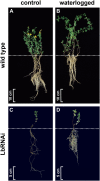Glycolysis and the tricarboxylic acid cycle are linked by alanine aminotransferase during hypoxia induced by waterlogging of Lotus japonicus
- PMID: 20089769
- PMCID: PMC2832266
- DOI: 10.1104/pp.109.150045
Glycolysis and the tricarboxylic acid cycle are linked by alanine aminotransferase during hypoxia induced by waterlogging of Lotus japonicus
Abstract
The role of nitrogen metabolism in the survival of prolonged periods of waterlogging was investigated in highly flood-tolerant, nodulated Lotus japonicus plants. Alanine production revealed to be a critical hypoxic pathway. Alanine is the only amino acid whose biosynthesis is not inhibited by nitrogen deficiency resulting from RNA interference silencing of nodular leghemoglobin. The metabolic changes that were induced following waterlogging can be best explained by the activation of alanine metabolism in combination with the modular operation of a split tricarboxylic acid pathway. The sum result of this metabolic scenario is the accumulation of alanine and succinate and the production of extra ATP under hypoxia. The importance of alanine metabolism is discussed with respect to its ability to regulate the level of pyruvate, and this and all other changes are discussed in the context of current models concerning the regulation of plant metabolism.
Figures









Similar articles
-
Regulation of Primary Metabolism in Response to Low Oxygen Availability as Revealed by Carbon and Nitrogen Isotope Redistribution.Plant Physiol. 2016 Jan;170(1):43-56. doi: 10.1104/pp.15.00266. Epub 2015 Nov 9. Plant Physiol. 2016. PMID: 26553649 Free PMC article.
-
CRISPR/Cas9 knockout of leghemoglobin genes in Lotus japonicus uncovers their synergistic roles in symbiotic nitrogen fixation.New Phytol. 2019 Oct;224(2):818-832. doi: 10.1111/nph.16077. Epub 2019 Aug 31. New Phytol. 2019. PMID: 31355948
-
Analysis of alanine aminotransferase in various organs of soybean (Glycine max) and in dependence of different nitrogen fertilisers during hypoxic stress.Amino Acids. 2010 Oct;39(4):1043-53. doi: 10.1007/s00726-010-0596-1. Epub 2010 Apr 23. Amino Acids. 2010. PMID: 20414691 Free PMC article.
-
Enzymes involved in l-lactate metabolism in humans.Mitochondrion. 2013 Nov;13(6):615-29. doi: 10.1016/j.mito.2013.08.011. Epub 2013 Sep 9. Mitochondrion. 2013. PMID: 24029012 Review.
-
Reconfiguration of N Metabolism upon Hypoxia Stress and Recovery: Roles of Alanine Aminotransferase (AlaAT) and Glutamate Dehydrogenase (GDH).Plants (Basel). 2016 May 31;5(2):25. doi: 10.3390/plants5020025. Plants (Basel). 2016. PMID: 27258319 Free PMC article. Review.
Cited by
-
Sugar modulation of anaerobic-response networks in maize root tips.Plant Physiol. 2021 Mar 15;185(2):295-317. doi: 10.1093/plphys/kiaa029. Plant Physiol. 2021. PMID: 33721892 Free PMC article.
-
Experimental comparison of two methods to study barley responses to partial submergence.Plant Methods. 2021 Apr 13;17(1):40. doi: 10.1186/s13007-021-00742-5. Plant Methods. 2021. PMID: 33849604 Free PMC article.
-
Oxygen Sensing via the Ethylene Response Transcription Factor RAP2.12 Affects Plant Metabolism and Performance under Both Normoxia and Hypoxia.Plant Physiol. 2016 Sep;172(1):141-53. doi: 10.1104/pp.16.00460. Epub 2016 Jul 2. Plant Physiol. 2016. PMID: 27372243 Free PMC article.
-
Nitrate nutrition influences multiple factors in order to increase energy efficiency under hypoxia in Arabidopsis.Ann Bot. 2019 Mar 14;123(4):691-705. doi: 10.1093/aob/mcy202. Ann Bot. 2019. PMID: 30535180 Free PMC article.
-
Identification and characterization of the TCA cycle genes in maize.BMC Plant Biol. 2019 Dec 27;19(1):592. doi: 10.1186/s12870-019-2213-0. BMC Plant Biol. 2019. PMID: 31881988 Free PMC article.
References
-
- Armstrong W, Brändle R, Jackson MB. (1994) Mechanisms of flood tolerance in plants. Acta Bot Neerl 43: 307–358
-
- Bailey-Serres J, Voesenek LACJ. (2008) Flooding stress: acclimations and genetic diversity. Annu Rev Plant Biol 59: 313–339 - PubMed
-
- Besson-Bard A, Pugin A, Wendehenne D. (2008) New insights into nitric oxide signaling in plants. Annu Rev Plant Biol 59: 21–39 - PubMed
Publication types
MeSH terms
Substances
LinkOut - more resources
Full Text Sources
Other Literature Sources

